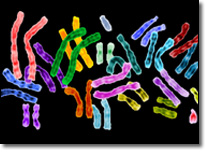Scientists say they've completed a genetic map of human chromosome 1
A team of American and British scientists say they've completed a genetic map of human chromosome 1, the single largest unit of genetic material in the human genome.

It's also the last of the 23 human chromosomes to be mapped. The effort involved more than 150 scientists and took about 10 years. Their findings appear in the May 18 issue of Nature.
Chromosome 1 makes up about 8 percent of the overall human genome, and contains about twice as many genes (3,141) as an average-sized chromosome. A thousand of the genes in chromosome 1 have never before been identified, the scientists said.
The chromosome plays a major role in health and well-being. Genetic mutations of chromosome 1 have been linked to more than 350 human diseases and structural alterations. Chromosome 1 genes are believed to play a role in a number of mental retardation syndromes, reports Forbes.
Chromosome 1 contains nearly twice as many genes as the average chromosome and makes up eight percent of the human genetic code.
It is packed with 3,141 genes and linked to 350 illnesses including cancer, Alzheimer's and Parkinson's disease.
"This achievement effectively closes the book on an important volume of the Human Genome Project," said Dr Simon Gregory who headed the sequencing project at the Sanger Institute in England.
The project was started in 1990 to identify the genes and DNA sequences that provide a blueprint for human beings.
Chromosome 1 is the biggest and contains, per chromosome, the greatest number of genes.
"Therefore it is the region of the genome to which the greatest number of diseases have been localized," added Gregory, from Duke University in the United States, informs Reuters.
According to Nature, i n 2000, two teams declared with great fanfare that they had produced a draft copy of the human genetic code, but there were many gaps and errors in this version. Another announcement, in 2003, marked the completion of a far more accurate 'finished' sequence by those involved in the public-financed Human Genome Project, although there are still a few gaps and uncertain areas in this one too.
Over the years, various research groups have also separately published sequences of all 22 numbered chromosomes, plus the X and Y chromosomes.
These projects have filled in some of the holes and pinned down the sequences with greater accuracy. Importantly, they also annotated the raw sequences by mapping on to them the position of genes and other important landmarks, making it more useful for other scientists to work with. Chromosome 1 is the final one to be mapped out in this way.
O.Ch.
Subscribe to Pravda.Ru Telegram channel, Facebook, RSS!





